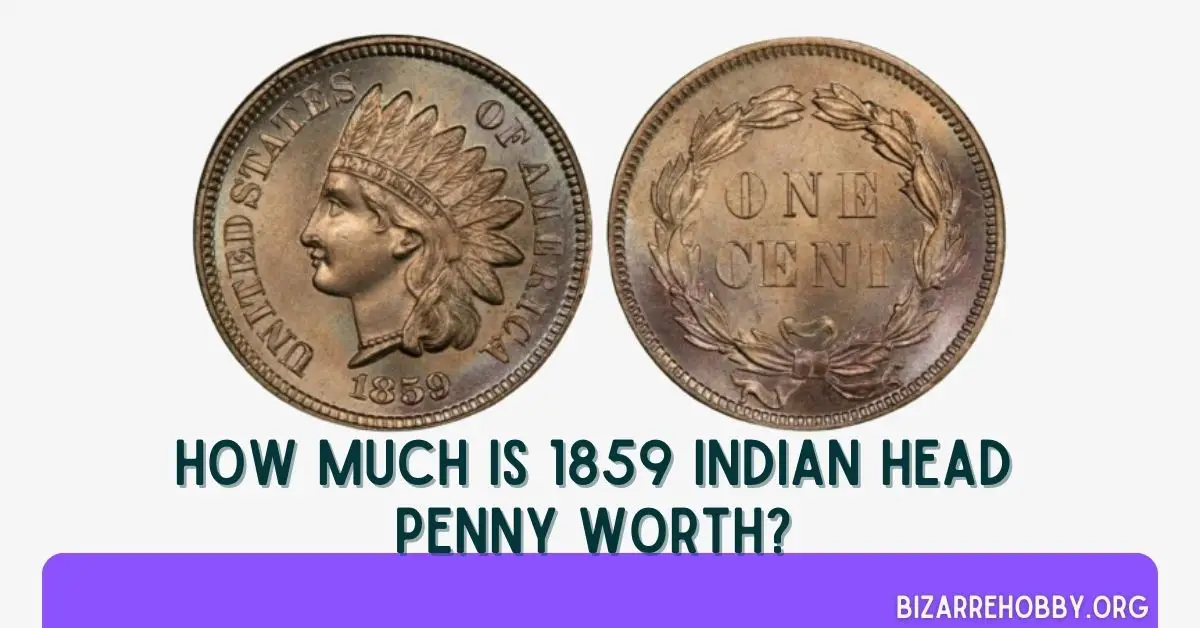When the 1859 Indian Head pennies first entered circulation, few could have predicted their future value as collectibles. Despite lacking silver content, their worth today is impressive and understandable.
These coins are not only beautiful and elegant but also the inaugural issue in their series, featuring a distinctive design unmatched by later mintings. Their age, over 160 years, makes finding high-condition specimens particularly challenging and valuable.
Table of Contents
- Value Chart For 1859 Indian Head Penny
- Historical Significance of the 1859 Indian Head Penny
- Types of 1859 Indian Head Penny
- Design of the 1859 Indian Head Penny
- Grading Guide for 1859 Indian Head Penny
- 1859 Indian Head Penny Value Guides
- Rare 1859 Indian Head Penny Error List
- Where to Sell Your 1859 Indian Head penny?
- What to look for in the 1859 Indian Head penny?
- Which 1859 Indian Head Penny is worth a lot of money?
- FAQs on 1859 Indian Head Penny Value
- Final Thoughts
Value Chart For 1859 Indian Head Penny
| Condition | 1859 No Mint Mark Penny |
|---|---|
| Good | $22 |
| Very good | $26 |
| Fine | $36 |
| Very fine | $48 |
| Extra fine | $130 |
| AU | $215 |
| MS 60 | $425 |
| MS 63 | $925 |
| PR 63 | $1,750 |
Historical Significance of the 1859 Indian Head Penny

The Indian Head pennies, minted from 1859 to 1909, are iconic American coins that preceded the Lincoln penny series. Unlike the large silver pennies introduced in 1793, these coins were smaller and made from a more affordable metal alloy.
They followed the two-year minting of the Flying Eagle pennies, of which only about 2,000 were circulated, making them highly collectible and often grouped with Indian cents.
The introduction of these coins marked the end of an era when cents were large and highly valued by the average American. Their smaller size and lighter weight were a practical improvement.
From the mint’s perspective, eliminating silver from these low-value denominations was economically beneficial. The production of small cupronickel coins was a sustainable solution.
Initially, Mint Director J.R. Snowden proposed featuring Christopher Columbus on the new penny. However, designer and chief engraver James B. Longacre suggested a different approach, citing Washington’s opposition to depicting real people on coinage.
Longacre designed a coin featuring an Indian girl’s portrait, which, despite resembling a Caucasian woman, was based on the Crouching Venus statue.
The feathered headdress symbolized Native American heritage, and the coin quickly became a favorite, seen as the most authentically American coinage of its time.
Types of 1859 Indian Head Penny
| Location | Year | Minted |
|---|---|---|
| Philadelphia | 1859 penny (No Mint mark) | 36,400,000 |
| Philadelphia | 1859 proof penny (No Mint mark) | Estimated 800 |
| Total | – | 36,400,800 |
Design of the 1859 Indian Head Penny
James B. Longacre, a talented artist and one of the first chief engravers of the US Mint, designed several American coins, including the Indian Head pennies minted from 1859 to 1909, before the Lincoln pennies took over.
Obverse Design of 1859 Indian Head Penny
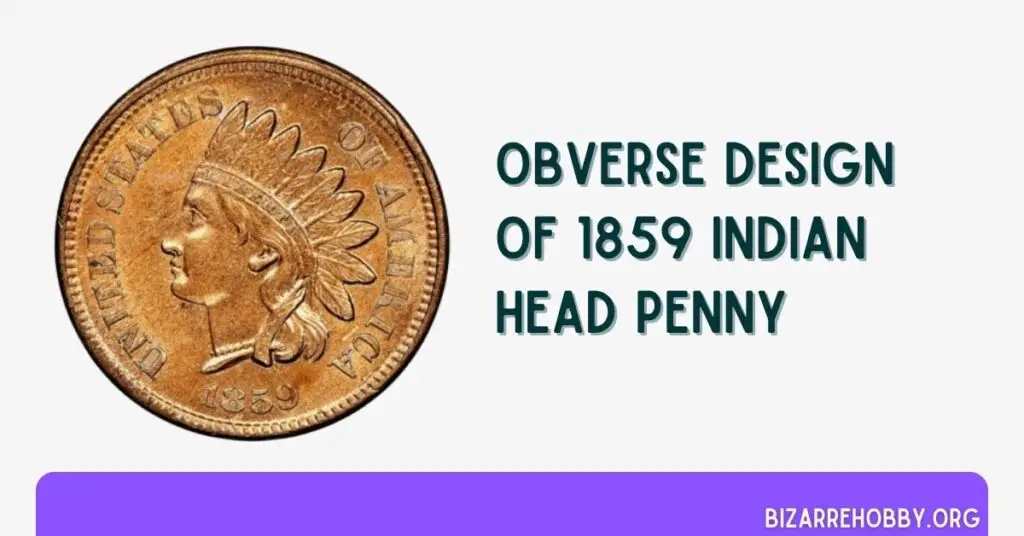
The obverse of the 1859 Indian Head penny features a simple yet striking design. It depicts Lady Liberty facing left, adorned with a traditional Indian headdress.
The band around her head is inscribed with “LIBERTY,” a mandatory inscription on American coinage. The date is also present on this side, with the full name of the United States split on either side of Liberty’s image.
Reverse Design of 1859 Indian Head Penny
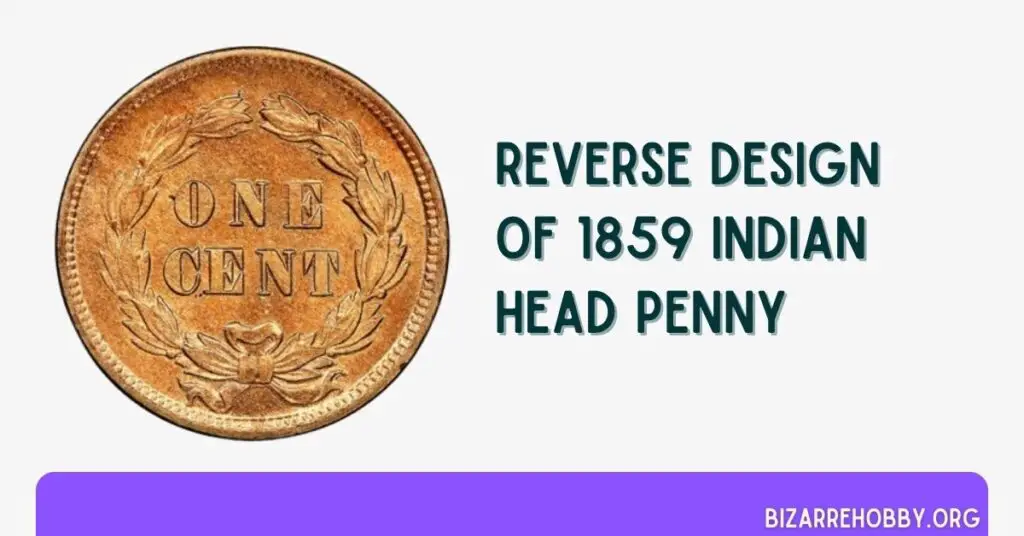
The reverse side is even simpler. It prominently displays the denomination “ONE CENT” surrounded by a laurel wreath. This design was unique to the first year of minting. Subsequent years featured a tiny shield and an oak wreath, with the only ornamentation being a bow tying the wreath at the bottom.
Technical Specifications of 1859 Indian Head Penny
| Specification | Detail |
|---|---|
| Face Value | One cent ($0.01) |
| Shape | Round |
| Compound | Copper-nickel alloy (an 88%: 12% ratio) |
| Coin Thickness | 0.09055 inches (2.30 mm) |
| Coin Diameter | 19.05 mm (0.75 inches) |
| Coin Weight | 0.16472 ounces (4.67 g) |
| Edge | Plain |
By understanding the history and features of the 1859 Indian Head penny, collectors can appreciate its significance and value. This coin not only represents a pivotal moment in American numismatics but also offers a glimpse into the nation’s evolving economic and cultural landscape.
Grading Guide for 1859 Indian Head Penny
Grading coins, especially those as old as the 1859 Indian Head penny, is a meticulous and demanding process. Every detail matters, as even the slightest variation can significantly impact a coin’s value, distinguishing a common piece from a highly prized collectible.
Given their age and the high prices they command in various grades, Indian Head pennies require careful evaluation. Only a seasoned expert can identify the subtle qualities that might elevate a coin’s worth beyond expectations.
| Sheldon Scale | Grade |
|---|---|
| 1 | Basal State-1 |
| 2 | Fair |
| 3 | Very Fair |
| 4, 5, 6 | Good |
| 7, 8, 10 | Very Good |
| 12, 15 | Fine |
| 20, 30 | Very Fine |
| 40 | Extremely Fine |
| 50 | About Uncirculated |
| 60 | Mint State |
| 65 | Mint State |
| 70 | Mint State |
For accurate valuation, refer to our comprehensive grading guide for grading Indian Head Penny. Understanding your coin’s grade is essential to determining its true market value.
1859 Indian Head Penny Value Guides
In 1859, the Philadelphia Mint produced all 36,400,800 Indian Head pennies. At that time, coins did not bear mint marks. Most of these were regular strikes intended for circulation, with approximately 800 proof specimens also minted.
1859 No Mint Mark Indian Head Penny Value
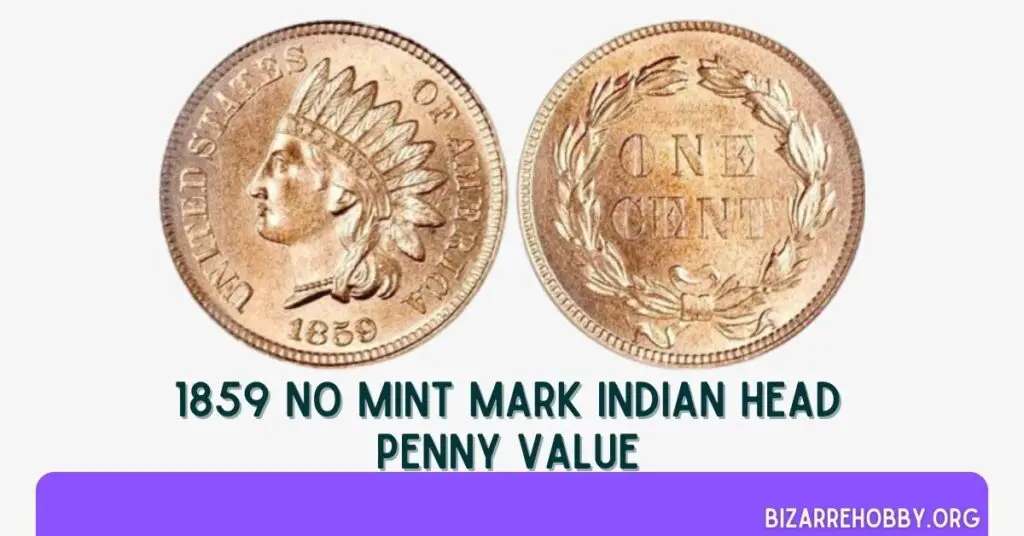
The 1859 Indian Head pennies from Philadelphia include both regular strikes and a limited number of proofs. Nearly all of the 36,400,000 coins produced were circulated, and their current value largely depends on their condition after years of use.
- Good Condition: These are the most affordable, typically priced between $22 and $26.
- Almost Uncirculated (AU): Coins in this condition can fetch between $215 and $410.
Uncirculated coins are particularly valuable, with collectors willing to pay premium prices for these pristine pieces. Here are some typical market values:
- MS 60: $425
- MS 61: $485
- MS 62: $675
- MS 63: $925
- MS 64: $1,700
- MS 65: $3,000
- MS 66: $5,800
Exceptionally rare and high-grade coins, such as those in MS 67, can command prices around $32,500 at auctions. Notably, an MS 66+ Indian Head cent sold for $34,500 in 2012, highlighting the potential value of these coins.
1859 proof Indian Head Penny without Mint mark Value
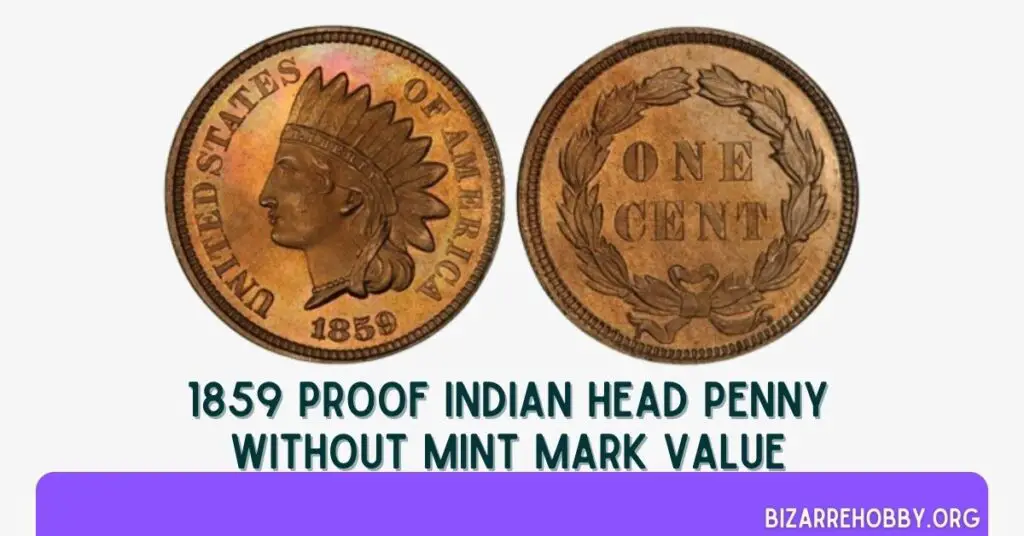
In addition to regular circulation coins, the Philadelphia Mint also produced proof pennies in 1859, with an estimated 800 pieces intended for collectors. These proofs come in three types: standard, cameo (CAM), and deep cameo (DCAM), each varying in appearance, minting quality, and value.
- PR 60: $875
- PR 61: $1,050
- PR 62: $1,300
- PR 63: $1,750
- PR 64: $2,700
- PR 65: $4,350
- PR 66: $8,000
- PR 67: $18,000
Proof pennies with CAM quality are generally more expensive:
- PR 63 CAM: $2,350
- PR 64 CAM: $4,250
- PR 65 CAM: $8,650
- PR 66 CAM: $20,000
The highest quality pieces, graded PR 67, can reach prices between $25,000 and $35,000 at auctions. For DCAM quality coins, expect to pay around $10,000 to $12,000 for a PR 65 grade.
Finding high-quality, scarce pennies can be challenging, but even lower-graded coins can exceed estimated values at auctions. For example, an 1859 PR 65 Indian Head penny sold for $29,900 in 2010, demonstrating the potential for significant returns on these historic coins.
Rare 1859 Indian Head Penny Error List
The simplicity of the 1859 Indian Head penny design likely contributed to the limited number of errors found in this series. However, there are two notable error types that collectors should be aware of:
1859 Indian Head Penny Die crack Error
Given that a single die was used to strike approximately 200,000 Indian pennies, it was inevitable that some dies would crack over time. Occasionally, these damaged dies continued to be used, resulting in coins with visible cracks.
These cracks can be bi-leveled, antipodal, shattered, retained, or radial, each leaving distinct marks on the coins. Due to the mint’s practice of using dies until they were completely worn out, die cracks were a common error in the Indian penny series. Coins with this error from 1859 can be valued between $20 and $40.
1859 Indian Head Penny Re-punched date Error
Re-punched dates are a frequent error for pennies minted in 1859, as mint workers manually stamped the dates onto the coins. This process led to numerous errors, ranging from subtle to easily noticeable.
The value of these coins can vary significantly based on the visibility of the error, typically ranging from $10 to $60.
However, some coins with prominent re-punched dates have fetched much higher prices at auctions, with records showing sales between $1,980 and $6,600.
Where to Sell Your 1859 Indian Head penny?
Knowing the value of your 1859 Indian Head penny is just the first step. Selling it online can be straightforward if you know where to look. Here are some recommended platforms, along with their pros and cons:
- eBay: Widely used, large audience, but competitive and requires seller fees.
- Heritage Auctions: Trusted auction house, attracts serious collectors, but may have higher fees and longer wait times.
- Coin Shops: Immediate sale, no shipping required, but potentially lower offers compared to online sales.
What to look for in the 1859 Indian Head penny?
When evaluating a 1859 Indian Head penny, several key factors can significantly influence its value:
- Condition: The overall state of the coin is paramount. Look for coins with minimal wear, clear details, and no significant damage. Coins in higher grades, such as MS (Mint State) or PR (Proof), are particularly valuable.
- Die Cracks: These are common errors where the die used to strike the coin has cracked, leaving visible lines on the penny. While these can decrease the aesthetic appeal, they can also make the coin more interesting to collectors.
- Re-punched Dates: Due to the manual stamping process used in 1859, many pennies have re-punched dates. These errors can range from subtle to very noticeable and can significantly increase the coin’s value.
- Proof Coins: Proof pennies from 1859 are rare and highly sought after. These coins were specially made for collectors and have a higher level of detail and a mirror-like finish.
- Patina and Color: The natural aging process can give coins a unique patina. Look for coins with an even, attractive color, as this can enhance their appeal and value.
- Historical Significance: As the first year of the Indian Head penny series, 1859 coins hold a special place in numismatic history. Their unique design and historical context add to their desirability.
Which 1859 Indian Head Penny is worth a lot of money?
- An 1859 MS 66+ Indian penny sold for $34,500 at Heritage Auctions on February 2, 2012.
- An 1859 PR 65 Indian penny sold for $29,900 at Heritage Auctions on January 6, 2010.
- An 1859 PR 66 CAM Indian penny fetched $27,600 at Heritage Auctions on February 9, 2006.
- An 1859 MS 64+ Snow-1 Indian penny with a re-punched date sold for $6,600 at Stack’s Bowers on March 5, 2019.
- An 1859 MS 65 Snow-2 Indian penny with a re-punched date sold for $2,820 at Heritage Auctions on February 16, 2017.
- An 1859 MS 65 Snow-3 Indian penny with a re-punched date sold for $1,980 at Stack’s Bowers on November 30, 2021.
FAQs on 1859 Indian Head Penny Value
How much is the 1859 Indian Head Penny worth?
The value of a circulated 1859 Indian Head penny without a mint mark ranges from $20 to $410. Well-preserved pieces are more valuable, typically costing between $330 and $5,000. The most valuable are those in MS 67 grade, estimated at $32,500.
What is the costliest Indian Head Penny?
The most expensive Indian Head penny is an 1864 error coin with an “L” on the ribbon, graded PR 65, which sold for $161,000 in 2011. Among regular pennies, the 1877 MS 66 Indian Head coin holds the record, selling for $149,500 in 2007. An MS 68 coin from 1902 with red toning sold for $144,000, and an 1897 PR 67+ DCAM coin reached $108,000 at Stack’s Bowers in 2021. The highest price for a standard 1877 proof penny in PR 67 grade was $97,750 in 2009, matched by a 1909 San Francisco mint penny in MS 67 grade sold in 2006.
What makes an 1859 Indian Head Penny rare?
Despite a high mintage of 36,400,000 pennies, the age of these coins makes them rare in higher grades. The limited number of proofs produced also adds to their scarcity. Additionally, the unique design, which changed the following year, makes these coins highly sought after by collectors.
Final Thoughts
The 1859 Indian Head penny is a fascinating piece of American numismatic history. Its unique design, historical significance, and potential for high value make it a prized addition to any collection.
Whether you’re a seasoned collector or a novice, understanding what to look for and the factors that influence the coin’s value can help you make informed decisions.
Always consider consulting with a professional grader to get an accurate assessment of your coin’s condition and worth.
